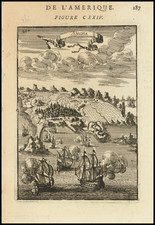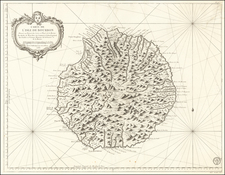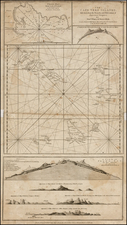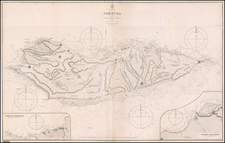Handsome and highly detailed manuscript map of Port Louis, the capital of Île-de-France (present-day Mauritius), done in pen and watercolor, showing the town, surrounding countryside, and the harbor, with many points keyed and identified in the accompanying legend. The plots of land in the town are done in orange and brown, denoting developed and undeveloped parcels. The extensive battlements and defenses are each identified. The map comprises two-thirds of the sheet, while the remaining third contains the extensive key.
A pencil notation at the bottom of the sheet indicates that the map was done by Jean Baptiste Charles Henri Hector, comte d'Estaing (1729-1794) and predates a memoir written by him in 1774. Because the map is on wove paper, and therefore cannot predate the 1790s, it is almost certainly a later copy of that map. In his bibliography of Mauritius, Toussaint does indicate two maps done by M. d'Estaing in 1774, though neither matches this precisely. The Dutch were the first Europeans to become interested in the island, taking possession in 1598. After exploiting the island's dense forests for a century and introducing the cultivation of sugar cane and cotton, in 1710 the Dutch abandoned the colony. The French soon claimed it as "Ile de France," and the island remained under the control of the French East India Company until 1767.
During the long war between France and England at the beginning of the 19th century, Mauritius proved to be an important strategic naval base, and as a result, the British took charge of the island in 1810, and the Treaty of Paris confirmed official British possession in 1814. It remained an important sugar producing colony, and in the 20th-century agricultural production was expanded to include tea, rice, and other produce.
Jean Baptiste Charles Henri Hector, comte d'Estaing
M. d'Estaing was a French general and admiral. He began his service as a soldier in the War of the Austrian Succession, briefly spending time as a prisoner of war of the British during the Seven Years' War. Naval exploits during the latter war prompted him to change branches of service, and he transferred to the French Navy.
Following France's entry into the American War of Independence in 1778, he led a fleet to aid the American rebels. He participated in a failed Franco-American siege of Newport, Rhode Island in 1778 and the equally unsuccessful 1779 Siege of Savannah before returning to France in 1780. His difficulties working with American counterparts are cited among the reasons these operations failed.
He spent time on Île-de-France at the end of the 1750s, before transferring to another overseas station.
Although he sympathized with revolutionaries during the French Revolution, he held a personal loyalty to the French royal family. Because of this he came under suspicion and was executed by guillotine in the Reign of Terror.










![[Napoleon in Exile] A Descriptive Sketch of The Island of St. Helena, Including Its Extent, Climate, Productions, Population, Government, Means of Defense, &c. &c.](https://storage.googleapis.com/raremaps/img/small/50902.jpg)



